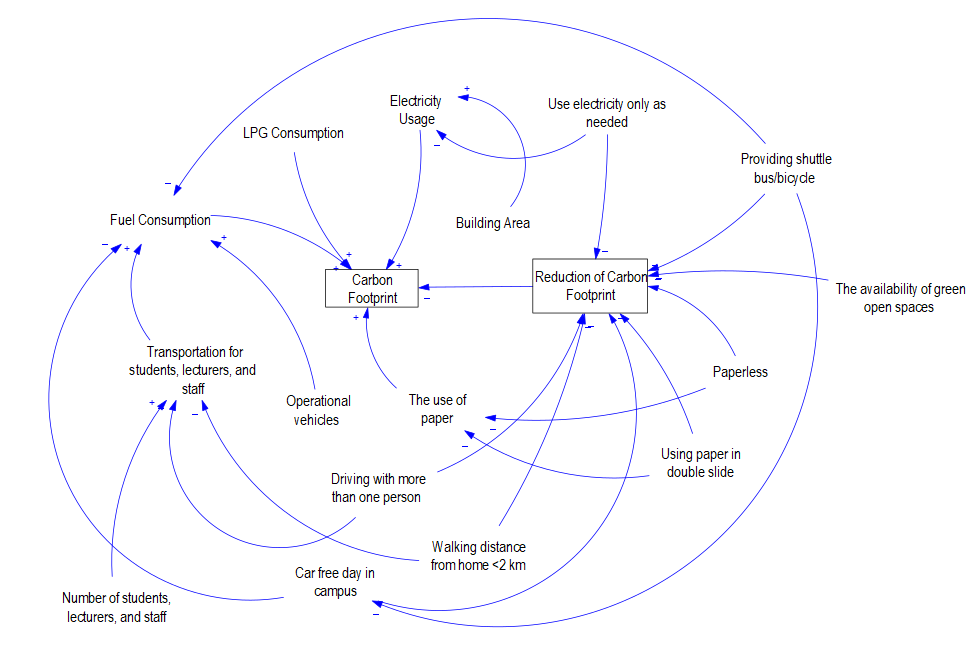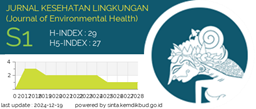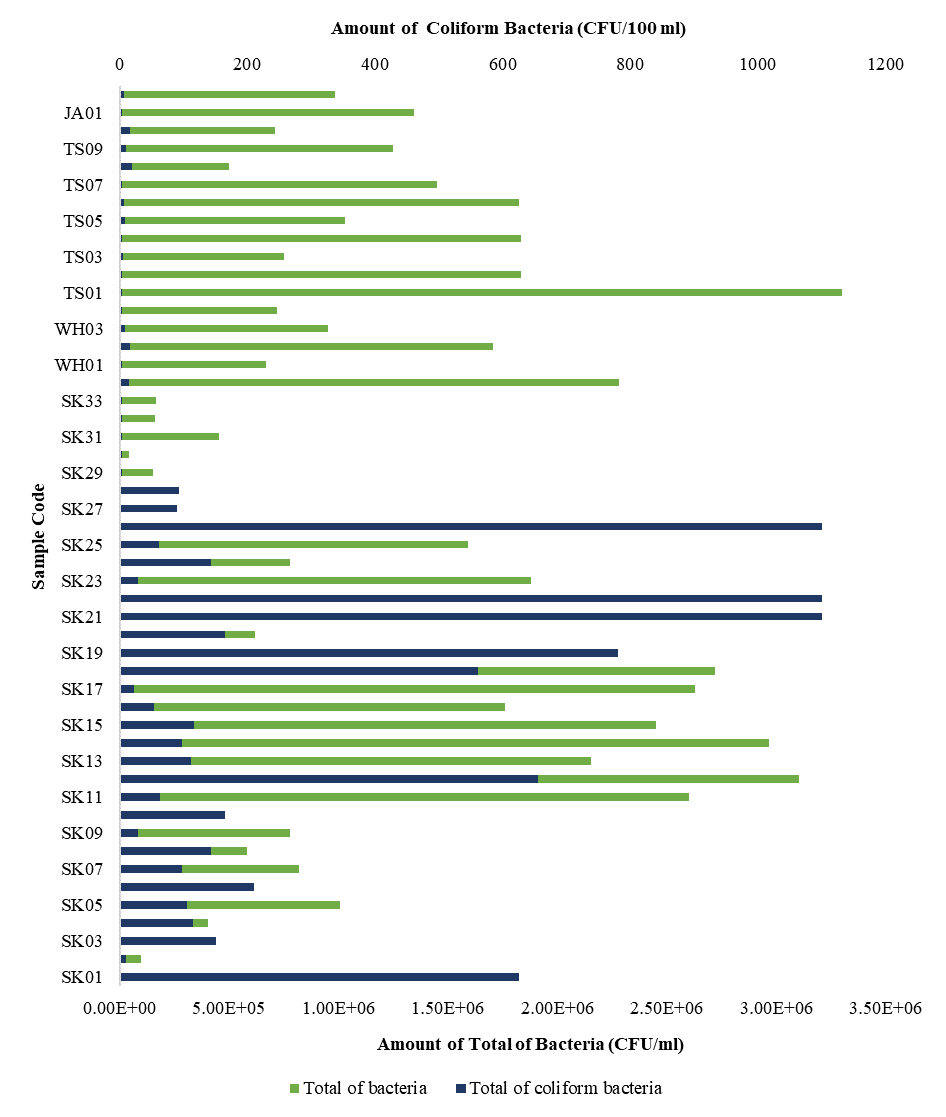Estimation of the Carbon Footprint of Campus Activities at the Faculty of Science and Technology, Universitas Jambi, After the Covid19 Pandemic

Introduction: The Covid19 pandemic altered campus activity patterns, impacting energy use and transportation. As operations resumed, universities became significant contributors to carbon emissions. Without intervention, these emissions risk accelerating environmental harm. This study estimates the post-pandemic carbon footprint of campus activities to provide a foundation for emission reduction strategies at the Faculty of Science and Technology, Universitas Jambi. Methods: This quantitative descriptive study used surveys and observations at Universitas Jambi (2023) with 132 respondents via stratified sampling. Emissions were estimated using GHG Protocol scopes 1–3 and IPCC 2019 factors. Carbon-related variables were analyzed and mapped using Vensim to visualize interrelations in campus emission activities. Results and Discussion: The post-pandemic carbon footprint of campus activities at the Faculty of Science and Technology, Universitas Jambi, totaled 490.9 tons CO₂-eq in 2023. Scope 2 emissions from electricity use dominated at 78.54%, followed by Scope 3 (commuting and paper usage) at 20.29%, and Scope 1 at 1.16%. Transportation, particularly student commuting, was the largest contributor within Scope 3. Scenario simulations using Vensim revealed that carpooling and car-free day programs could reduce emissions significantly. Behavior-based interventions, including energy-saving practices and digital document usage, were identified as effective strategies to improve sustainability in daily academic operations. Conclusion: The findings support the development of targeted emission reduction strategies aligned with post-pandemic campus conditions. Its integrated approach contributes a data-driven framework for sustainable policy planning, especially for post-pandemic institutions in tropical and developing country contexts.
Kasman M, Riyanti A, Apriani NR. Estimasi Jejak Karbon dari Aktivitas Kampus Universitas Batanghari. Jurnal Daur Lingkungan. 2020;3(2):42–46. https://doi.org/10.33087/daurling.v3i2.52
Rosadi D, Saily R, Zaiyar Z, Jusi U. Identifikasi Jejak Karbon Skala Rumah Tangga Sebagai Upaya Mengatasi Perubahan Iklim. Indonesian Journal of Construction Engineering and Sustainable Development (Cesd). 2022;5(2):15–23. https://doi.org/10.25105/cesd.v5i2.15629
Ridhosari B, Rahman A. Carbon Footprint Assessment at Universitas Pertamina from the Scope of Electricity, Transportation, and Waste Generation: Toward A Green Campus and Promotion of Environmental Sustainability. Journal of Cleaner Production. 2020;246(1):1-13. https://doi.org/10.1016/j.jclepro.2019.119172
Syafrudin S, Zaman B, Budihardjo MA, Yumaroh S, Gita DI, Lantip DS. Carbon Footprint of Academic Activities: A Case Study in Diponegoro University. IOP Conference Series: Earth and Environmental Science. 2020;448(1):1-7. https://doi.org/10.1088/1755-1315/448/1/012008
Gu Y, Wang H, Xu J, Wang Y. Quantification of interlinked environmental footprints on a sustainable university campus: A nexus analysis perspective. Applied Energy. 2019;246(2):65–76. https://doi.org/10.1016/j.apenergy.2019.04.015
Samara F, Ibrahim S, Yousuf ME, Armour R. Carbon Footprint at a United Arab Emirates University: GHG Protocol. Sustainability. 2022;14(5):1–22. https://doi.org/10.3390/su14052522
Artun E. Assessment of Carbon Footprint of a Campus with Sustainability Initiatives. Gazi University Journal of Science. 2021;34(3):652–663. https://doi.org/10.35378/gujs.726553
El Geneidy S, Baumeister S, Govigli VM, Orfanidou T, Wallius V. The Carbon Footprint of A Knowledge Organization and Emission Scenarios For A Post-Covid19 World. Environmental Impact Assessment Review. 2021;91(2):1-17. https://doi.org/10.1016/j.eiar.2021.106645
Ismail A. Potensi Penurunan Emisi Gas Rumah Kaca (Grk) Dalam Kegiatan Belajar di Rumah Secara on-Line: Analisis Jejak Karbon (Carbon Footprint Analysis). Jukung (Jurnal Teknik Lingkungan). 2020;6(2):195–203. https://doi.org/10.33087/daurling.v2i2.27
Nyangon J, Darekar A. Advancements in Hydrogen Energy Systems: A Review Of Levelized Costs, Financial Incentives and Technological Innovations. Innovation and Green Development. 2024;3(3):1-19. https://doi.org/10.1016/j.igd.2024.100149
Devezas T, Tick A, Sarygulov A, Rukina P. The Slow Pace of Green Transformation: Underlying Factors and Implications. Energies. 2024;17(19):1-26. https://doi.org/10.3390/en17194789
Hulu BJD. The Study of CO2 Absorption Using the Canopy with Vines at President University. NUCLEUS. 2022;3(1):70–75. https://doi.org/10.37010/nuc.v3i1.784
Serlina Y, Putra FA, Lestari RA, Bachtiar VS. Analisis Jejak Karbon Dari Aktivitas Transportasi di Universitas Andalas. Jurnal Serambi Engineering. 2024;IX(3):9889–9897. https://doi.org/10.32672/jse.v9i3.1979
Dağlioğlu ST. Carbon Footprint Analysis of Ege University within the Scope of Environmental Sustainability. Commagene Journal of Biology. 2021;5(1):51–58. https://doi.org/10.31594/commagene.865194
Shboul B, Koh SL, Veneti C, Herghelegiu AI, Zinca AE, Pourkashanian M. Evaluating Sustainable Development Practices In A Zero Carbon University Campus: A Pre and Post-Covid19 Pandemic Recovery Study. Science of The Total Environment. 2023;896(1):1-15. https://doi.org/10.1016/j.scitotenv.2023.165178
Rahayuningsih M, Handayani L, Abdullah M, Arifin MS, Kunci K. Kajian Jejak Karbon (Carbon Footprint) di FMIPA Universitas Negeri Semarang. Indonesian Journal of Conservation. 2021;10(1):48–52. https://doi.org/10.15294/ijc.v10i1.30038
Cortes A, dos Muchangos L, Tabornal KJ, Tolabing HD. Impact of the Covid19 Pandemic on the Carbon Footprint of a Philippine University. Environmental Research: Infrastructure and Sustainability. 2022;2(4):1-14 https://doi.org/10.1088/2634-4505/acaa52
Sun L, Kaufman MF, Sirk EA, Durga S, Mahowald NM, You F. Covid19 Impact on an Academic Institution’s Greenhouse Gas Inventory: The Case of Cornell University. Journal of Cleaner Production. 2022;363(1):1-8. https://doi.org/10.1016/j.jclepro.2022.132440
Silva DAL, Giusti G, Rampasso IS, Junior ACF, Marins MAS, Anholon R. The Environmental Impacts of Face-To-Face And Remote University Classes During the Covid19 Pandemic. Sustainable Production and Consumption. 2021;27(1):1975–1988. https://doi.org/10.1016/j.spc.2021.05.002
Baharom NA, Yusuf SY, Za’aba SK, Mohd Noor N, Ahmad NA, Ahmad, WAA, Boboc M. Carbon Footprint Assessment From Purchased Electricity Consumption and Campus Commute in Universiti Malaysia Perlis (UniMAP): Pre-and During Covid19 Pandemic. Proceedings of the 3rd International Conference on Green Environmental Engineering and Technology: IConGEET 2021, Penang, Malaysia. Springer Nature. 2022; 214(1): 9–17. https://doi.org/10.1007/978-981-16-7920-9_2
Yiğit M, Şeneren M. The Effects of the Covid19 Period on Carbon Footprint in Sakarya University Esentepe Campus. Sakarya University Journal of Science. 2023;27(1):14–21. https://doi.org/10.16984/saufenbilder.1113024
Yin Z, Jiang X, Lin S, Liu J. The Impact of Online Education On Carbon Emissions In The Context of the Covid19 Pandemic–Taking Chinese Universities As Examples. Applied Energy. 2022;314(1):1-13. https://doi.org/10.1016/j.apenergy.2022.118875
DeWeese J, Ravensbergen L, El-Geneidy A. Travel Behaviour and Greenhouse Gas Emissions During the Covid19 Pandemic: A Case Study In A University Setting. Transportation Research Interdisciplinary Perspectives. 2022;13(1):1-9. https://doi.org/10.1016/j.trip.2021.100531
Dirga A, Setiawan T, Breliastiti R. Analisis Jejak Karbon Dalam Proses Pembelajaran Kelas. Owner. 2024;8(3):2064–2075. https://doi.org/10.33395/owner.v8i3.2144
Rahayu P, Andini I, Mukaromah H. Jejak Karbon Mahasiswa: Perbandingan Sebelum dan Saat Diberlakukan Kebijakan Belajar dari Rumah. Region: Jurnal Pembangunan Wilayah dan Perencanaan Partisipatif. 2023;18(2):580-593. https://doi.org/10.20961/region.v18i2.56143
Battistini R, Passarini F, Marrollo R, Lantieri C, Simone A, Vignali V. How to Assess the Carbon Footprint of a Large University? The Case Study of University of Bologna’s Multicampus Organization. Energies. 2023;16(1):1–22. https://doi.org/10.3390/en16010166
Kiehle J, Kopsakangas-Savolainen M, Hilli M, Pongrácz E. Carbon Footprint at Institutions of Higher Education: The Case of the University of Oulu. Journal of Environmental Management. 2023;329(1):1–14. https://doi.org/10.1016/j.jenvman.2022.117056
Valls-Val K, Bovea MD. Carbon Footprint Assessment Tool for Universities: CO2UNV. Sustainable Production and Consumption. 2022;29(1):791–804. https://doi.org/10.1016/j.spc.2021.11.020
Gitarskiy ML. The Refinement To The 2006 IPCC Guidelines For National Greenhouse Gas Inventories. Fundamental and Applied Climatology. 2019;2(1): 5-13. http://dx.doi.org/10.21513/0207-2564-2019-2-05-13
Sanaky MM. Analisis Faktor-Faktor Keterlambatan Pada Proyek Pembangunan Gedung Asrama Man 1 Tulehu Maluku Tengah. Jurnal Simetrik. 2021;11(1):432–439. https://doi.org/10.31959/js.v11i1.615
Nurhayat N, Handika RA. Prediksi Jejak Karbon Fakultas Sains dan Teknologi Kampus Pinang Masak Universitas Jambi. Jurnal Daur Lingkungan. 2019;2(2):51–58. https://doi.org/10.33087/daurling.v2i2.27
Ghani MR. Analisis Model Sistem Dinamis pada Penjualan Olahan Buah Alpukat di PT XYZ Menggunakan Software Vensim. Jurnal Kontruksi. 2024;2(1):99–108. https://doi.org/10.61132/konstruksi.v2i1.55
Zakaria R, Aly SH, Hustim M, Oja ADM. A Study of Assessment and Mapping of Carbon Footprints to Campus Activities in Hasanuddin University Faculty of Engineering. IOP Conference Series: Materials Science and Engineering. 2020;875(1):1–9. https://doi.org/10.1088/1757-899X/875/1/012023
Hajjarianti P, Fitriani N, Zagita LC. Carbon Footprint of Universitas Airlangga Before and During the Covid19 Pandemic. Journal of Sustainability Perspectives. 2023;3(1):271–284. https://doi.org/10.14710/jsp.2023.20835
Orovwode HE, Matthew S, Amuta E, Agbetuyi FA, Odun-Ayo I. Carbon Footprint Evaluation and Environmental Sustainability Improvement Through Capacity Optimization. International Journal of Energy Economics and Policy. 2021;11(3):454–459. https://doi.org/10.32479/ijeep.10209
Vrachni A, Christogerou A, Thomopoulos GA, Marazioti C, Angelopoulos GN. Carbon Footprint of the University of Patras in Greece: Evaluating Environmental Culture and Campus’ Energy Management towards 2030. Pollutants. 2022;2(3):347–362. https://doi.org/10.3390/pollutants2030024
Ezhilkumar MR, Ville AI, Mambo DA, Maruthu SA, Sridharan G, Sriram R. Estimation of Carbon Footprint Pattern at Nile University of Nigeria: A Technical Campus in Nigeria. E3S Web of Conferences. 2023;455(1):1–9. https://doi.org/10.1051/e3sconf/202345503014
Cooper J, Bird M, Acha S, Amrit P, Chachuat B, Shah N, Matar O. The Carbon Footprint of a UK Chemical Engineering Department - The Case of Imperial College London. Procedia CIRP. 2023;116(1):444–449. https://doi.org/10.1016/j.procir.2023.02.075
Filimonau V, Archer D, Bellamy L, Smith N, Wintrip R. The Carbon Footprint of A UK University During the Covid19 Lockdown. Science of the Total Environment. 2021;756(1):1-12. https://doi.org/10.1016/j.scitotenv.2020.143964
Clabeaux R, Carbajales-Dale M, Ladner D, Walker T. Assessing the Carbon Footprint of a University Campus using a Life Cycle Assessment Approach. Journal of Cleaner Production. 2020;273(1):1-16. https://doi.org/10.1016/j.jclepro.2020.122600
Haseeb M, Tahir Z, Batool SA, Majeed A, Ahmad SR, Kanwal S. The Carbon Footprint of A Public Sector University Before and During the Covid19 Lockdown. Global Nest Journal. 2022;24(1):29–36. https://doi.org/10.30955/gnj.004222
Auger C, Hilloulin B, Boisserie B, Thomas M, Guignard Q, Rozière E. Open-Source Carbon Footprint Estimator: Development and University Declination. Sustainability. 2021;13(8):1–15. https://doi.org/10.3390/su13084315
Yañez P, Sinha A, Vásquez M. Carbon Footprint Estimation in A University Campus: Evaluation and Insights. Sustainability. 2020;12(1):1–15. https://doi.org/10.3390/SU12010181
Rocha TDA, Silva LB, Alves EBBM, Jacovine LAG. Carbon footprint In An Educational Institution and Compensation Potential In Urban Forests. Environmental Development. 2023;46(1):1-11. https://doi.org/10.1016/j.envdev.2023.100860
Subirana M, Sunyer J, Colom-Cadena A, Bordas A, Casabon J, Gascon M. Monitoring and Assessment of CO2 and NO2 in schools within The Sentinel Schools Network of Catalonia During the Covid19 Era. Chemosphere. 2024;362(1):1-11. https://doi.org/10.1016/j.chemosphere.2024.142575
Tan E, Scarff C, Saunderson RB, Soyer HP, Bruce F. Location Matters! Optimizing Venue Selection and Attendance Format to Lower the Carbon Footprint of Air Travel to The Australasian College of Dermatologists ASM. Australasian Journal of Dermatology. 2024;65(8):266–269. https://doi.org/10.1111/ajd.14381
Wang C, Parvez AM, Mou J. The Status and Improvement Opportunities Towards Carbon Neutrality of a University Campus in China: A Case Study On Energy Transition and Innovation Perspectives. Journal of Cleaner Production. 2023;414(1):1-10. https://doi.org/10.1016/j.jclepro.2023.137521
Zaidan E, Abulibdeh A, Jabbar R, Onat NC, Kucukvar M. Evaluating the Impact of the Covid19 Pandemic on the Geospatial Distribution of Buildings’ Carbon Footprints Associated with Electricity Consumption. Energy Strategy Reviews. 2024;52(1):1-22. https://doi.org/10.1016/j.esr.2024.101350
Abulibdeh A. Towards Zero-Carbon, Resilient, and Community-Integrated Smart Schools and Campuses: A Review. World Development Sustainability. 2024;5(1):1-16. https://doi.org/10.1016/j.wds.2024.100193
Ma B, Bashir MF, Peng X, Strielkowski W, Kirikkaleli D. Analyzing Research Trends of Universities’ Carbon Footprint: An Integrated Review. Gondwana Research. 2023;121(1):259–275. https://doi.org/10.1016/j.gr.2023.05.008
Alalwan AA, Baabdullah AM, Dwivedi YK, Al-Sulaiti KI, Khoualdi K, Albanna H. Utilization of Green Internet of Things (GIoT) Applications Towards Sustainable Performance: The Antecedents and Consequences of Carbon Footprint. Journal of Cleaner Production. 2024;467(1):1-14. https://doi.org/10.1016/j.jclepro.2024.142956
Bowler AL, Rodgers S, Meng F, McKechnie J, Cook DJ, Watson NJ. Development of an Open-Source Carbon Footprint Calculator of the UK Craft Brewing Value Chain. Journal of Cleaner Production. 2024;435(1):1-13. https://doi.org/10.1016/j.jclepro.2023.140181
Jiang Q, Kurnitski J. Performance Based Core Sustainability Metrics for University Campuses Developing Towards Climate Neutrality: A Robust PICSOU Framework. Sustainable Cities and Society. 2023;97(1):1-16. https://doi.org/10.1016/j.scs.2023.104723
Halimanjaya A. The Political Economy of Indonesia’s Renewable Energy Sector and Its Fiscal Policy Gap. International Journal of Economics, Finance and Management Sciences. 2019;7(2):45-64. http://dx.doi.org/10.11648/j.ijefm.20190702.12

This work is licensed under a Creative Commons Attribution-NonCommercial-ShareAlike 4.0 International License.
1. Copyright of all journal manuscripts is held by the Jurnal Kesehatan Lingkungan.2. Formal legal provisions to access digital articles of electronic journal are subject to the provision of the Creative Commons Attribution-ShareAlike license (CC BY-NC-SA), which means that Jurnal Kesehatan Lingkungan is rightful to keep, transfer media/format, manage in the form of databases, maintain, and publish articles.
3. Published manuscripts both printed and electronic are open access for educational, research, and library purposes. Additionally, the editorial board is not responsible for any violations of copyright law.
JKESLING by UNAIR is licensed under a Creative Commons Attribution-ShareAlike 4.0 International License.







































